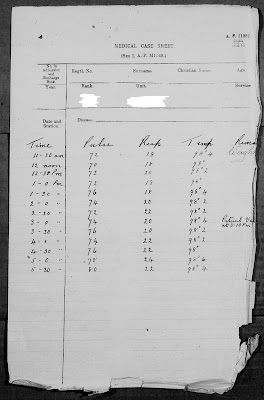Venereal disease was a huge problem in the British Army. As Alan Ramsay Skelley writes in The Victorian Army at Home, "The incidence of the disease in 1860 was 369 cases per 1000 men. The loss of service was equivalent to the withdrawal of every soldier from the army for eight days or of two full battalions every year in Britain." He continues, "... although the threat it posed in 1899 was considerably less than in 1860, never less than one man in ten, and for most of the period one in five or an even higher proportion, underwent treatment each year."
Hardly any wonder then that a special Army Form dealing with the treatment of syphilis cases was felt necessary to print. I've removed the man's details from the form on this post, but it states that he probably picked up the disease -and almost certainly from a brothel - at the Suddher Bazaar in Bareilly, India on the 3rd March 1912. He would undergo treatment for the next six months.
Also in this man's papers is Army Form 11237, a Medical Case Sheet which in this particular case shows that the man concerned was having his pulse, breathing and temperature checked every half an hour. The results appear to be normal.
The images on this post are Crown Copyright, The National Archives.












